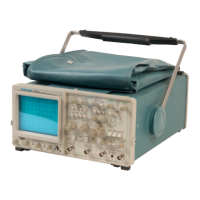Appendix A-2465 Operators
POWER-UP
TESTS
Power-up
tests
are divided into two main parts: Kernel
tests and Confidence tests.
KERNEL TESTS
The Kernel
tests
confirm proper operation of the
memory associated with the basic instrument's micro-
processor (RAM and ROM) and of any instrument options
that are present. A failure of
a
Kernel
test
is
indicated by
a flashing TRIG'D indicator on the instrument front panel.
Even with a Kernel failure, the instrument may still be
put into the operating mode by pressing in the A/B TRlG
button. However,
its
operation will be unpredictable.
CONFIDENCE TESTS
The Confidence tests are performed after successful
completion of all Kernel tests. Confidence testing for any
options present in the instrument will automatically be
included. A failure of any Confidence
test
at power on
is
indicated in the bottom line of the crt readout. The failure
display has the following format:
TEST
XX
FAIL
YY
where
XX
is
the two-digit hexadecimal test number and
YY
represents the failure code for the failed
test.
Brief descriptions of the
tests
are listed in Table A-I. A
Confidence test failure may not render the instrument
inoperable. The instrument may still be placed into the
operating mode by pressing in the
A/B TRlG button;
however,
it
may not meet all specifications.
Table
A-I
Confidence Test Numbers and Descriptions
Test Number
Description
IRQ-Checks that interrupts are occurring
and that correct time interval exists
between interrupt occurrences.
SWITCH STUCK-Checks for momentary
switches that may be stuck closed.
READOUT BOARD-Checks interfaces
with the Readout circuit board and the
readout RAM.
EAROM-Checks the
EAROM interface
and verifies the calibration constants stored
in the EAROM.
MAIN BOARD-Partially checks the Main
circuit board by operating the Auto Level
function on the Line Trigger source.

